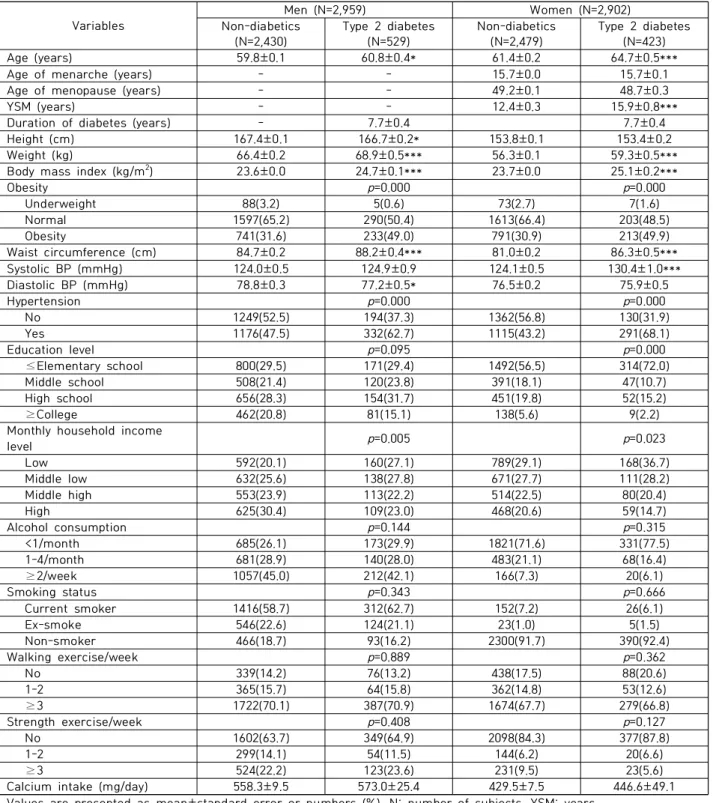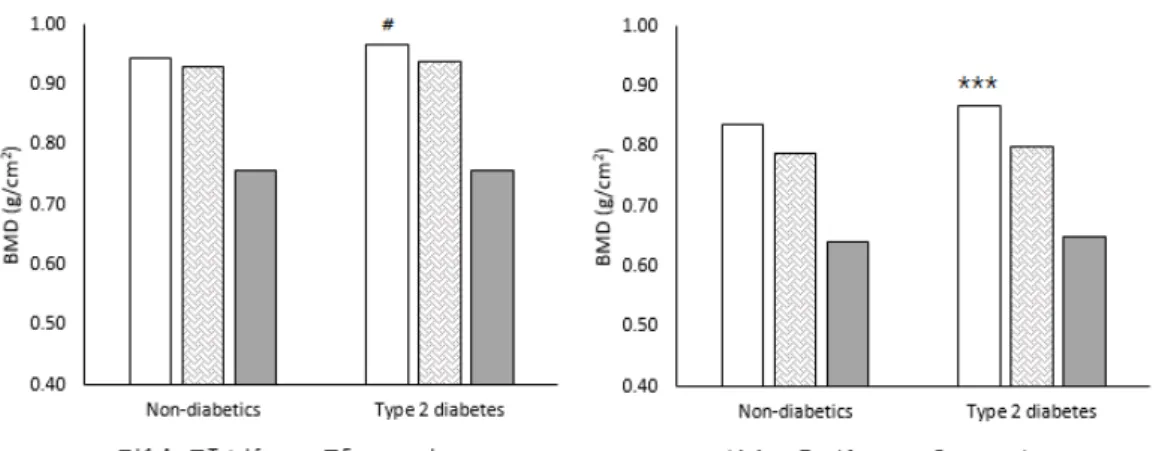JKSCI
Bone mineral density in type 2 diabetic patients aged 50 years or older in men and postmenopausal women in Korea
*
Jeong-Ran Cho*, Dong Jin Chung**
*Professor, Dept. of Health Administration, Kwangju Women’s University, Gwangju, Korea
**Professor, Dept. of Internal Medicine, Chonnam National University Medical School, Gwangju, Korea
[Abstract]
Relationship between bone mineral density (BMD) and type 2 diabetes is still inconsistent. Recently, many epidemiologic data show that fracture risk is increased in type 2 diabetic patients regardless of BMD status. In this study, we used nation-wide data from 2008 to 2011 Korea National Health and Nutrition Examination Survey (KNHANES) to analyze the BMD status in patients with type 2 diabetes compared to non-diabetics. We included subjects aged 50 years or older in men (N=2,959, 2,430 without diabetes, 529 with type 2 diabetes) and postmenopausal women (N=2,902, 2,479 without diabetes, 423 with type 2 diabetes). Subjects with history of medication for osteoporosis or with illness or malignancy affecting bone metabolism were excluded. Data of anthropometric measurements and demographic characteristics were collected by trained examiner. Serum was separated from peripheral venous blood samples obtained after 8 hours of fasting. BMD was measured at lumbar spine and femur using dual-energy X-ray absorptiometry (DXA). There was a significant positive association between lumbar spine BMD and type 2 diabetes after adjusting age, gender, body mass index, monthly house income, education level, physical activity, daily calcium intake and vitamin D concentration by multiple regression analysis in all subjects. In the subgroup analysis by gender, this association was maintained both in male and female after adjusting those confounding factors. However, femur BMD was not different between type 2 diabetic and non-diabetic subjects. In conclusion, lumbar spine BMD was significantly higher in type 2 diabetic patients aged 50 years or more in men and postmenopausal women compared to non-diabetic subjects.
▸Key words: KNHANES, diabetes, bone mineral density, osteoporosis, fracture
∙First Author: Jeong-Ran Cho, Corresponding Author: Dong Jin Chung
*Jeong-Ran Cho (jrcho@kwu.ac.kr), Dept. of Health Administration, Kwangju Women’s University
**Dong Jin Chung (djchung@chonnam.ac.kr), Dept. of Internal Medicine, Chonnam National University Medical School
∙Received: 2021. 07. 28, Revised: 2021. 08. 09, Accepted: 2021. 08. 13.
∙This study used the data from The Fourth and Fifth Korea National Health and Nutrition Examination Survey(KNHANES
Ⅳ-V), 2008-2011, Korea Centers for Disease Control and Prevention
Copyright ⓒ 2021 The Korea Society of Computer and Information http://www.ksci.re.kr pISSN:1598-849X | eISSN:2383-9945



